Looking Up Values in Tables
Problem
You're using tabular data in calculations and you need an easy way to look up values in the table for use in other calculations.
Solution
Use the built-in functions Lookup, VLookup, HLookup, Match, or Index.
Discussion
Excel provides five functions to help you access data in tabular form. These functions come in handy when performing calculations that require looking up data from standard tables. For example, you can develop a spreadsheet to perform thermodynamic calculations and include standard steam tables in this spreadsheet. This way, instead of manually looking up fluid properties to use in your calculations, you can automatically include that data via the lookup functions discussed here.
LOOKUP
The syntax for LOOKUP is =LOOKUP(lookup value, lookup vector, result vector). Lookup finds the value in result vector corresponding to the position of the value in lookup vector that matches lookup value. The lookup vector must be sorted in ascending order (see Recipe 3.9). Also, the lookup and result vectors may be row or column ranges.
You can use text or a number as the lookup value; the function just compares the lookup value to the data stored in the lookup vector to find a match. This is an important caveat with this function (and the others discussed here), as no interpolation is performed. The function looks for an exact match and if it does not find one, it returns the value in the result vector corresponding to the value in the lookup vector that is closest to but less than the lookup value. (Take a look at the recipes in Chapter 8 to learn how to interpolate data in Excel.)
Figure 3-24 illustrates a typical application of LOOKUP. In this example, we have a simple table of data that presents design factors, say for ship structural design, as a function of length of the ship under consideration, the ship's hull material, and the units used. (Don't bother looking up this table of data in a marine design handbookit doesn't exist. I just made it up for illustration purposes.)
Let's say we have a design formula, or better yet a whole series of calculations that must be performed, that requires the design factor as input. Including the design factor table in the spreadsheet allows you to conveniently select the factor by specifying the length, material type, and units, rather than looking up the data in a handbook and entering it manually. This is especially handy if you distribute your spreadsheet to someone else.
The three values in cells F14 through F16 are user input values corresponding to the given length, units, and material, respectively. The design factor corresponding to this given data is contained in cell F17. The formula in cell F17 that actually performs the lookup is:
=LOOKUP(F14, IF(F15="ft",D8:D12,E8:E12), IF(F16="Steel", F8:F12,G8:G12))
This formula looks more complicated than it is, due to the nested IF functions.
Figure 3-24. LOOKUP
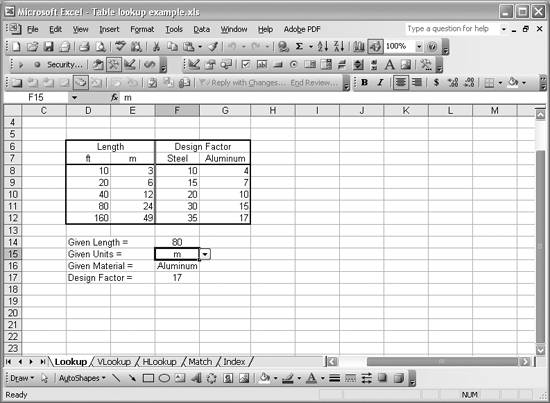
|
Basically, the given length, cell F14, is used as the value to look up in the lookup vector, but the lookup vector itself depends on which units are selected. An IF function is used to test the given units and return the correct lookup vector. Another IF function is used to test the given material and return the correct result vector. The design factor is extracted from the result vector on the row corresponding to the row containing the given lookup value (the given length, in this case).
|
VLOOKUP
The syntax for VLOOKUP is =VLOOKUP(lookup value, table, column, match flag). VLOOKUP searches for the given lookup value in the first column of the range of cells given by table and returns the value on the corresponding row in the given column. match flag is optional. If it is set to TRue or is omitted, then VLOOKUP will find an exact match or a close match. In this case, the first column in the given table should be sorted in ascending order (see Recipe 3.9). If an exact match is not found, the function returns the value in the given column corresponding to the value in the first column that is closest to but less than the lookup value. If match flag is false, VLOOKUP will look only for exact matches. If one is not found, the function returns #N/A, indicating the absence of an exact match.
Figure 3-25 shows a spreadsheet containing a table of physical properties for water. The first column of the table contains temperatures ranging from 10 to 90°C. Typical calculations would involve looking up physical properties in such a table for use in other calculations.
Physical properties of water for a given temperature can be retrieved from this table using VLOOKUP. In Figure 3-25, cell E17 contains the given temperature for which properties are retrieved. In this case, density, internal energy, enthalpy, entropy, specific heats, sound speed, and viscosity corresponding to the given temperature are shown in cells E18 through E25. Each of these cells contains a formula that utilizes VLOOKUP. For example, cell E18 contains the formula =VLOOKUP($E$17,$C$4:$K$12,2). The value to be looked up in the first column of the data table is stored in cell E17; this is the given temperature. The data table itself is stored in the cell range C4:K12. The last parameter in this formula indicates the column in the data table from which to retrieve data corresponding to the given temperature. Column 2 in this case is the density of water. The remaining cells contain similar formulas. The only differences are the last parameter in VLOOKUP (i.e., the column index from which to retrieve the desired value).
Figure 3-25. VLOOKUP
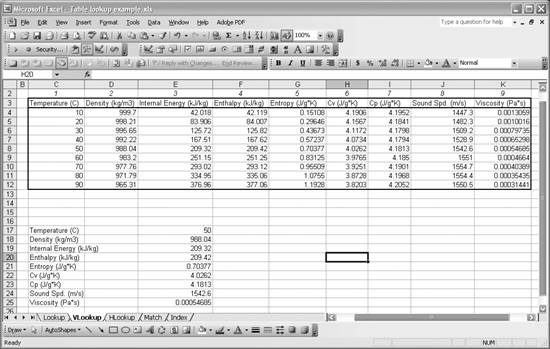
HLOOKUP
HLOOKUP is very similar to VLOOKUP; however, HLOOKUP uses the first row of data in a given cell range as the lookup array. The syntax for HLOOKUP is = HLOOKUP(lookup value, table, row, match flag). The only difference between this syntax and that of VLOOKUP is the third parameter; HLOOKUP requires a row number to be used to retrieve the result.
Figure 3-26 contains the same data shown in Figure 3-25; however, in this new example the data has been transposed. Now, temperatures are on the first row instead of in the first column.
|
Physical properties of water for a given temperature can be retrived from this table using HLOOKUP. For example, cell D17 extracts the density corresponding to the temperature given in cell D16. The formula in cell D17 is =HLOOKUP($D$16,$D$4:$L$12,2). The formulas for the other properties in cells D18 through D24 are very similar; only the result row number changes.
Figure 3-26. HLOOKUP
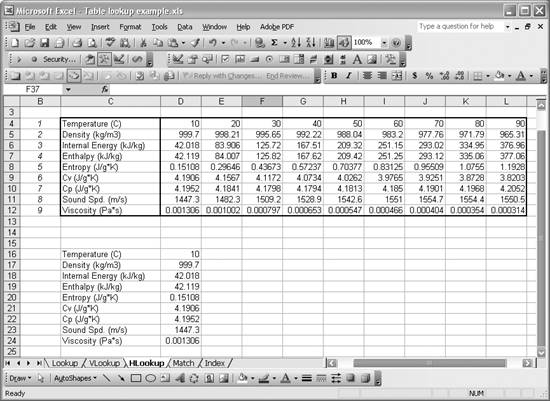
MATCH
MATCH returns the position of an item in an array. For example, in the spreadsheet shown in Figure 3-27 we could use MATCH to return the position of the cell containing the text Sound Spd. (m/s) in the array of cells C4 to C12. In this case, the position returned would be 8. The syntax for MATCH is =MATCH(lookup value, lookup array, match type). Here, lookup value is the value to be looked up in the array lookup array. The last parameter, match type, tells MATCH how you want to determine a match. If match type is 0, then MATCH looks for an exact match. If match type is -1, then Match returns the position of the smallest value greater than or equal to lookup value. If match type is 1, then MATCH returns the position of the largest value less than or equal to lookup value. Remember, MATCH returns the position of the matched value, not the value itself.
The spreadsheet in Figure 3-27 shows how you might use MATCH. In this case, we have the same data table as in the HLOOKUP example. This time, however, in cell D18 we have this formula: =HLOOKUP(D17,D4:L12,MATCH(C18,C5:C12,0)+1). This time I nested a call to MATCH as the third parameter in HLOOKUP. In the previous example, I specified a row in which to look up the result. In this case, I use MATCH to find the row corresponding to the description of the property selected in cell C18. Cell C18 contains a drop-down listbox that allows you to select any of the properties in the table except the temperature property. I used the same data validation technique described earlier in this recipe to create the selection list in this example.
Figure 3-27. MATCH
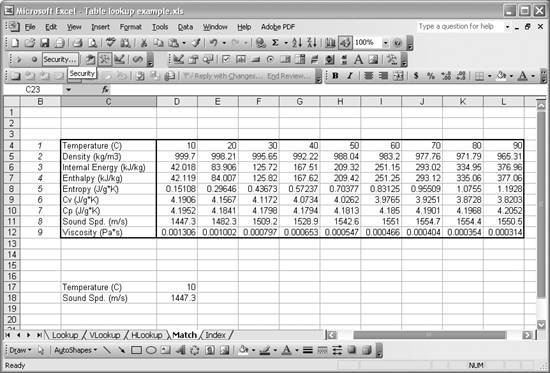
The call to MATCH in the call to HLOOKUP returns the position of the selected description in the list of descriptions contained in cells C5 to C12. To get the proper row number for the table in the cell range C4:L12, you have to add 1 to the value returned by MATCH since the number of rows in the description cell list is shifted by 1 from the data table.
INDEX
INDEX is useful for extracting a value from a table (cell range) given the position of the value in the table. The syntax for INDEX is =INDEX(cell reference, row, column). INDEX will return the value in the cell at position row and column in the range specified by cell reference. This is like extracting the value of an element in a matrix given its row and column position.
Figure 3-28 shows a spreadsheet containing a set of data resembling a 4x3 matrix.
Cell D10 contains the value of element [2,2] extracted using INDEX. The formula in cell D10 is =INDEX(D4:F7,2,2).
If you want to extract an entire row, set the column to 0 in the call to INDEX. Likewise, to extract an entire column, set the row to 0. To extract an entire row or column at a time, you need to use array formulas. These are nothing more than formulas that act over a range of cells (instead of over a single cell, like the formulas I've discussed so far).
Figure 3-28. INDEX
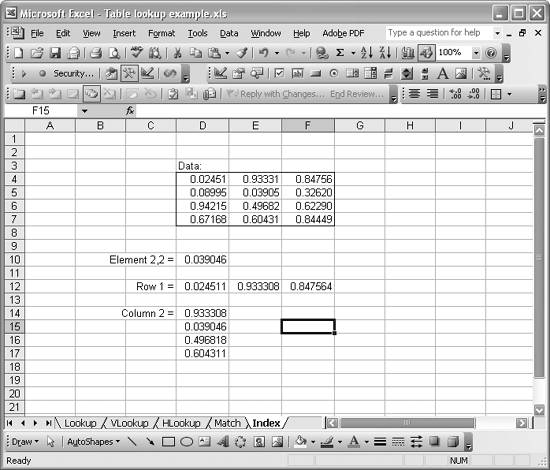
To extract the first row as shown in Figure 3-28, I first selected the destination cell range D12:F12 by clicking and dragging the mouse. Then I pressed the equals sign to begin writing the formula: =INDEX(D4:F7,1,0). Notice that I set the column to 0, indicating that I want an entire row. To enter this formula, which is now an array formula, press Ctrl-Shift-Enter instead of the usual Enter. This tells Excel you're entering an array formula, and it will fill all the selected cells with results of the formula you entered.
|
To extract the entire second column as shown in Figure 3-28, select the range D14:D17 and Ctrl-Shift-Enter the formula =INDEX(D4:F7,0,2). In this case, the row is set to 0, indicating that you want to extract an entire column.
INDEX is handy when working with matrices or matrix-like data and calculations. See Chapter 7 for more recipes dealing with matrix calculations.
See Also
In this recipe, I used and briefly discussed Excel's IF function. While its use is fairly straightforward, you can read more about it and other logical functions in Excel's online help. Look for the topic "Logical Functions."
Using Excel
- Introduction
- Navigating the Interface
- Entering Data
- Setting Cell Data Types
- Selecting More Than a Single Cell
- Entering Formulas
- Exploring the R1C1 Cell Reference Style
- Referring to More Than a Single Cell
- Understanding Operator Precedence
- Using Exponents in Formulas
- Exploring Functions
- Formatting Your Spreadsheets
- Defining Custom Format Styles
- Leveraging Copy, Cut, Paste, and Paste Special
- Using Cell Names (Like Programming Variables)
- Validating Data
- Taking Advantage of Macros
- Adding Comments and Equation Notes
- Getting Help
Getting Acquainted with Visual Basic for Applications
- Introduction
- Navigating the VBA Editor
- Writing Functions and Subroutines
- Working with Data Types
- Defining Variables
- Defining Constants
- Using Arrays
- Commenting Code
- Spanning Long Statements over Multiple Lines
- Using Conditional Statements
- Using Loops
- Debugging VBA Code
- Exploring VBAs Built-in Functions
- Exploring Excel Objects
- Creating Your Own Objects in VBA
- VBA Help
Collecting and Cleaning Up Data
- Introduction
- Importing Data from Text Files
- Importing Data from Delimited Text Files
- Importing Data Using Drag-and-Drop
- Importing Data from Access Databases
- Importing Data from Web Pages
- Parsing Data
- Removing Weird Characters from Imported Text
- Converting Units
- Sorting Data
- Filtering Data
- Looking Up Values in Tables
- Retrieving Data from XML Files
Charting
- Introduction
- Creating Simple Charts
- Exploring Chart Styles
- Formatting Charts
- Customizing Chart Axes
- Setting Log or Semilog Scales
- Using Multiple Axes
- Changing the Type of an Existing Chart
- Combining Chart Types
- Building 3D Surface Plots
- Preparing Contour Plots
- Annotating Charts
- Saving Custom Chart Types
- Copying Charts to Word
- Recipe 4-14. Displaying Error Bars
Statistical Analysis
- Introduction
- Computing Summary Statistics
- Plotting Frequency Distributions
- Calculating Confidence Intervals
- Correlating Data
- Ranking and Percentiles
- Performing Statistical Tests
- Conducting ANOVA
- Generating Random Numbers
- Sampling Data
Time Series Analysis
- Introduction
- Plotting Time Series Data
- Adding Trendlines
- Computing Moving Averages
- Smoothing Data Using Weighted Averages
- Centering Data
- Detrending a Time Series
- Estimating Seasonal Indices
- Deseasonalization of a Time Series
- Forecasting
- Applying Discrete Fourier Transforms
Mathematical Functions
- Introduction
- Using Summation Functions
- Delving into Division
- Mastering Multiplication
- Exploring Exponential and Logarithmic Functions
- Using Trigonometry Functions
- Seeing Signs
- Getting to the Root of Things
- Rounding and Truncating Numbers
- Converting Between Number Systems
- Manipulating Matrices
- Building Support for Vectors
- Using Spreadsheet Functions in VBA Code
- Dealing with Complex Numbers
Curve Fitting and Regression
- Introduction
- Performing Linear Curve Fitting Using Excel Charts
- Constructing Your Own Linear Fit Using Spreadsheet Functions
- Using a Single Spreadsheet Function for Linear Curve Fitting
- Performing Multiple Linear Regression
- Generating Nonlinear Curve Fits Using Excel Charts
- Fitting Nonlinear Curves Using Solver
- Assessing Goodness of Fit
- Computing Confidence Intervals
Solving Equations
- Introduction
- Finding Roots Graphically
- Solving Nonlinear Equations Iteratively
- Automating Tedious Problems with VBA
- Solving Linear Systems
- Tackling Nonlinear Systems of Equations
- Using Classical Methods for Solving Equations
Numerical Integration and Differentiation
- Introduction
- Integrating a Definite Integral
- Implementing the Trapezoidal Rule in VBA
- Computing the Center of an Area Using Numerical Integration
- Calculating the Second Moment of an Area
- Dealing with Double Integrals
- Numerical Differentiation
Solving Ordinary Differential Equations
- Introduction
- Solving First-Order Initial Value Problems
- Applying the Runge-Kutta Method to Second-Order Initial Value Problems
- Tackling Coupled Equations
- Shooting Boundary Value Problems
Solving Partial Differential Equations
- Introduction
- Leveraging Excel to Directly Solve Finite Difference Equations
- Recruiting Solver to Iteratively Solve Finite Difference Equations
- Solving Initial Value Problems
- Using Excel to Help Solve Problems Formulated Using the Finite Element Method
Performing Optimization Analyses in Excel
- Introduction
- Using Excel for Traditional Linear Programming
- Exploring Resource Allocation Optimization Problems
- Getting More Realistic Results with Integer Constraints
- Tackling Troublesome Problems
- Optimizing Engineering Design Problems
- Understanding Solver Reports
- Programming a Genetic Algorithm for Optimization
Introduction to Financial Calculations
- Introduction
- Computing Present Value
- Calculating Future Value
- Figuring Out Required Rate of Return
- Doubling Your Money
- Determining Monthly Payments
- Considering Cash Flow Alternatives
- Achieving a Certain Future Value
- Assessing Net Present Worth
- Estimating Rate of Return
- Solving Inverse Problems
- Figuring a Break-Even Point
Index
EAN: 2147483647
Pages: 206

